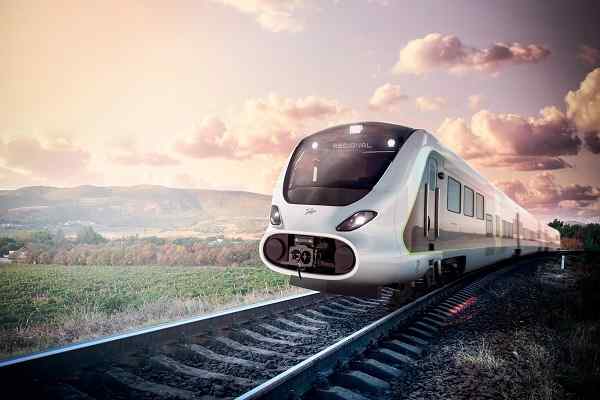 Delhi unveils ambitious Urban Mobility Vision: Luxury Metro Coaches, New Tunnels and Pod Taxi
Delhi unveils ambitious Urban Mobility Vision: Luxury Metro Coaches, New Tunnels and Pod Taxi Qatar approves Saudi Rail Link Agreement, Accelerating Gulf Railway Vision 2030
Qatar approves Saudi Rail Link Agreement, Accelerating Gulf Railway Vision 2030 UP Govt plans to introduce Water Metro services in Ayodhya, Varanasi & Prayagraj
UP Govt plans to introduce Water Metro services in Ayodhya, Varanasi & Prayagraj India’s First Urban Ropeway begins Trial Run in Varanasi, Set to carry 1 Lakh passengers daily
India’s First Urban Ropeway begins Trial Run in Varanasi, Set to carry 1 Lakh passengers daily India and Bhutan to Build First-Ever Rail Link: ₹4,033 Cr Project to Boost Regional Connectivity
India and Bhutan to Build First-Ever Rail Link: ₹4,033 Cr Project to Boost Regional Connectivity Patna to launch Eco-Friendly Water Metro; Trial Run soon between Digha and Kangan Ghats
Patna to launch Eco-Friendly Water Metro; Trial Run soon between Digha and Kangan Ghats Air India Group set to launch Flights Operations from Navi Mumbai International Airport
Air India Group set to launch Flights Operations from Navi Mumbai International Airport Chennai to launch 25-Year Mobility Plan with Unified QR Ticketing and One-App Transit System
Chennai to launch 25-Year Mobility Plan with Unified QR Ticketing and One-App Transit System Kochi Metro bags ₹4.4 crore contract to prepare DPR for Mumbai Water Metro Proejct
Kochi Metro bags ₹4.4 crore contract to prepare DPR for Mumbai Water Metro Proejct Navi Mumbai International Airport set for September launch; IndiGo and Akasa Air to lead Operations
Navi Mumbai International Airport set for September launch; IndiGo and Akasa Air to lead Operations
Why the SilverLine Semi High-Speed Rail Project makes sense for Kerala?
 (Image is for representative purpose only)
(Image is for representative purpose only)
The SilverLine Semi High-Speed Rail Project to be built by the government of Kerala will link Thiruvananthapuram in the south to Kasargode in the north. The high-speed train will cover 530 km in four hours at a maximum speed of 200kmph. The project has received its share of criticism, much of it from political quarters, but also some academic sections.
For Kerala, with its saturated road network, the building of a fast, environmentally-sustainable high-speed rail link must surely be seen as a sound governance response. Indeed, a study of INDC (Intended Nationally Determined Contribution) plans under the Paris Climate Agreement is instructive in this context. The EU study on mobility notes that HSR is the least-cost emission option among all modes of long-distance transportation.
Critics have put forward three principal lines of argument, namely, its alleged adverse environmental impact, financial unviability, and technical unsuitability.
The most compelling environmental issue before us is climate change. Building capacities now to achieve a carbon net-neutral world over the next three to four decades is a core aspect of the national strategy of all nations. In this context, the SilverLine project scores high with respect to India’s own climate objective of achieving net-zero emissions by 2070.
The impact of HSR is no longer a theoretical expectation. We have more than 60 years of experience in Japan with Shinkansen or “bullet train” (1964), more than 40 years in Europe (France 1981), and more than a decade with the world’s largest HSR network (China 2008). Let us recall the driving forces behind Japan’s decision to develop the Shinkansen. In the context of the global oil crisis, energy-insecure Japan wanted to develop a public transportation system that was energy-efficient and would also address national concerns with respect to imbalanced regional growth. After the Kyoto Protocol was signed, more efforts were made to increase the speed of the various series of Shinkansen to meet the objectives of energy efficiency and CO2 reductions. Trains in the current N700 series of HSRs consume half the energy consumed by the first series of trains, and run 32 per cent faster.
Recent impact assessment studies are mostly of China’s HSR of around 25,000 km. A study published in Nature indicates that the new HSR routes have resulted in the reduction of 11.183 million tons of CO2 equivalent to GHG emissions or 1.33 per cent of GHG emissions in China’s transport sector.
The creation of a modern and industrially-competitive Japan despite its minimal natural resources would not have been imaginable without a transformative transport arrangement like the Shinkansen. It is equally important to note here that the HSR programme was developed and implemented by Japan National Railways at a time when it was under immense financial stress.
Large-scale infrastructure projects are not based on short-term financial viability considerations alone. When the London Underground was conceived, it was not considered financially viable. Today, London’s economic activities are inconceivable without it. Green technologies that we consider cheaper than fossil fuel technologies were not initially financially viable, and were unable to survive without government subsidies.
This notion of development should be the standard against which large projects such as SilverLine are to be evaluated. There are abundant international examples of the role played by large capital-intensive infrastructure projects in the transformation of the town and country, regions, and nations.
(This article first appeared in the print edition of TIE on March 2, 2022 under the title ‘On a green track’.)





